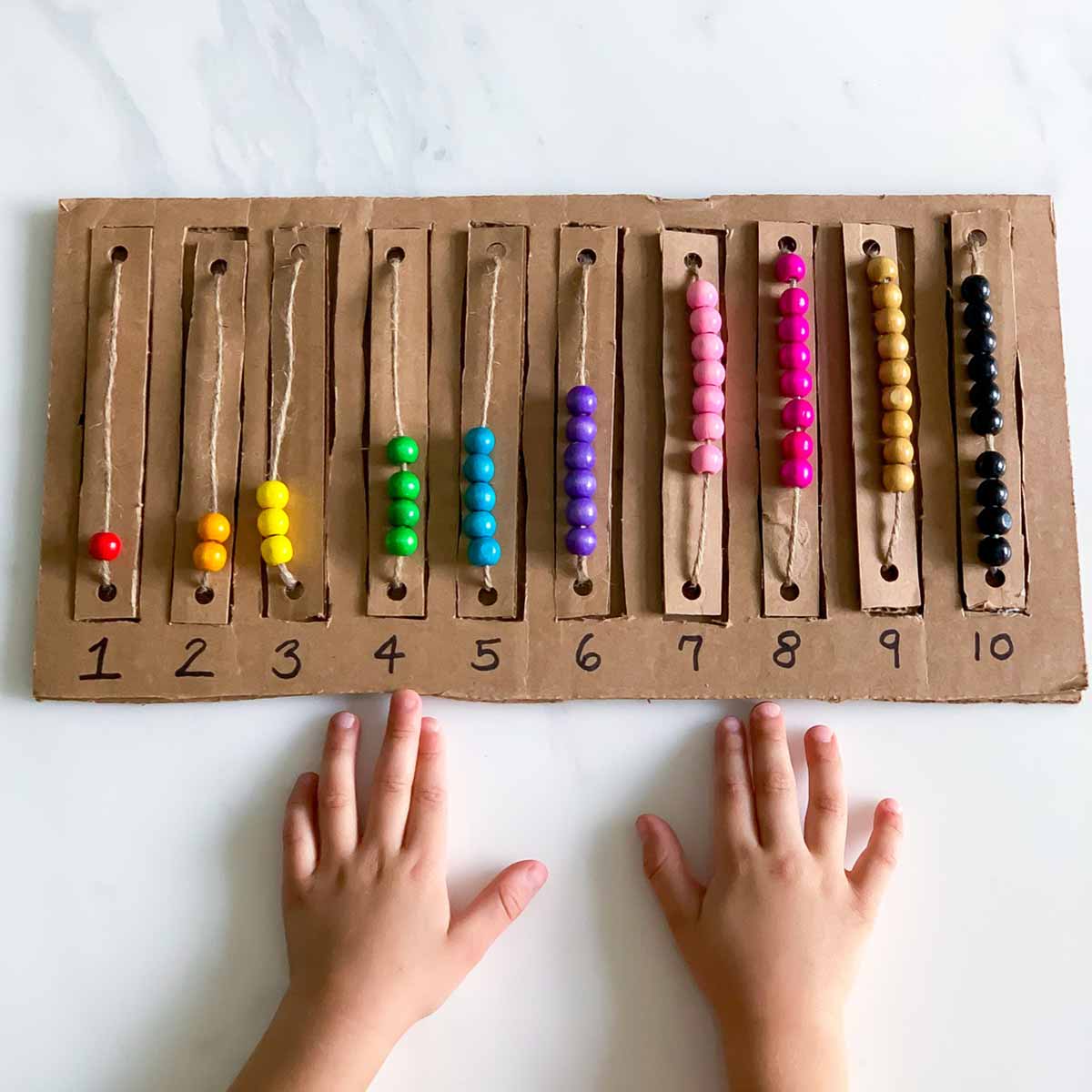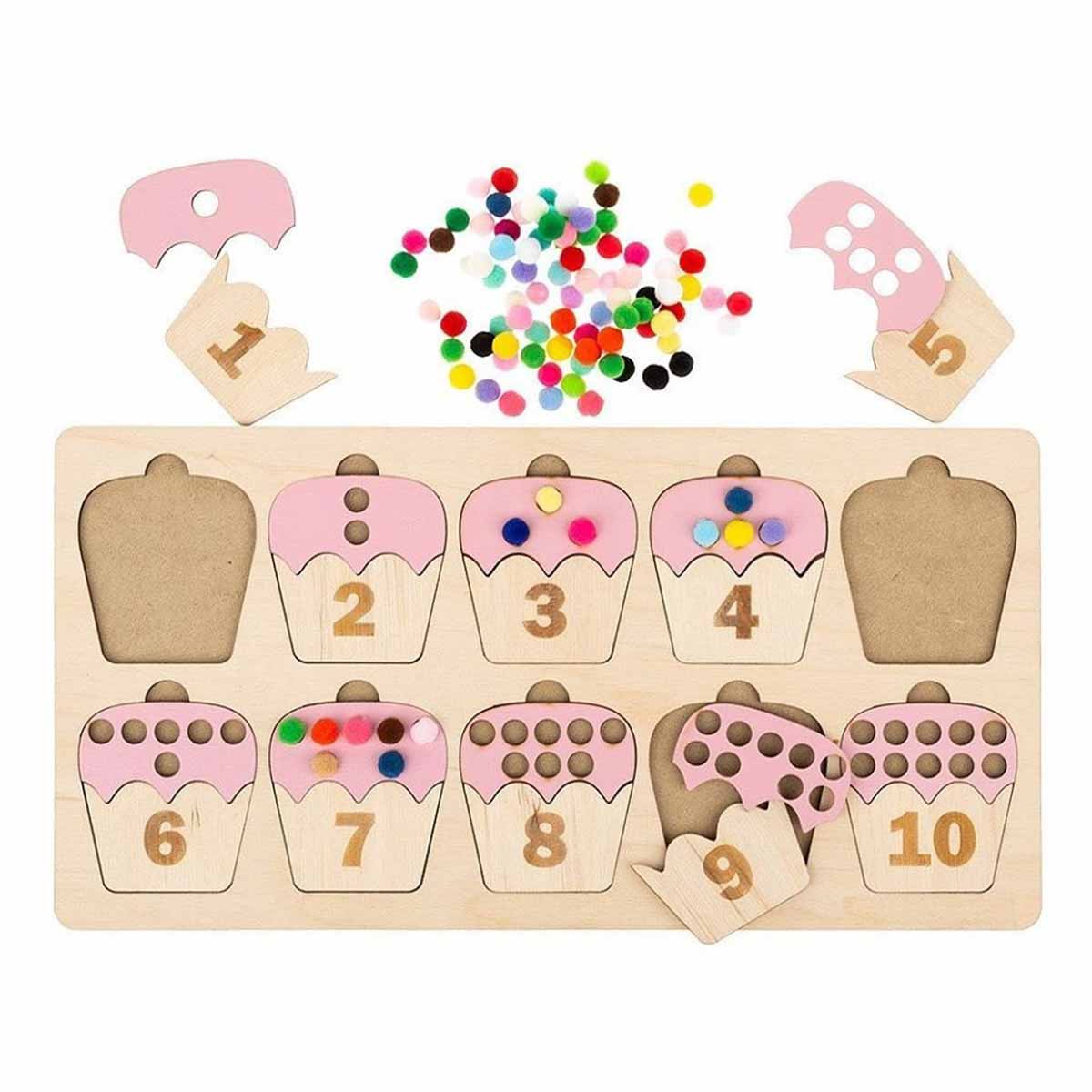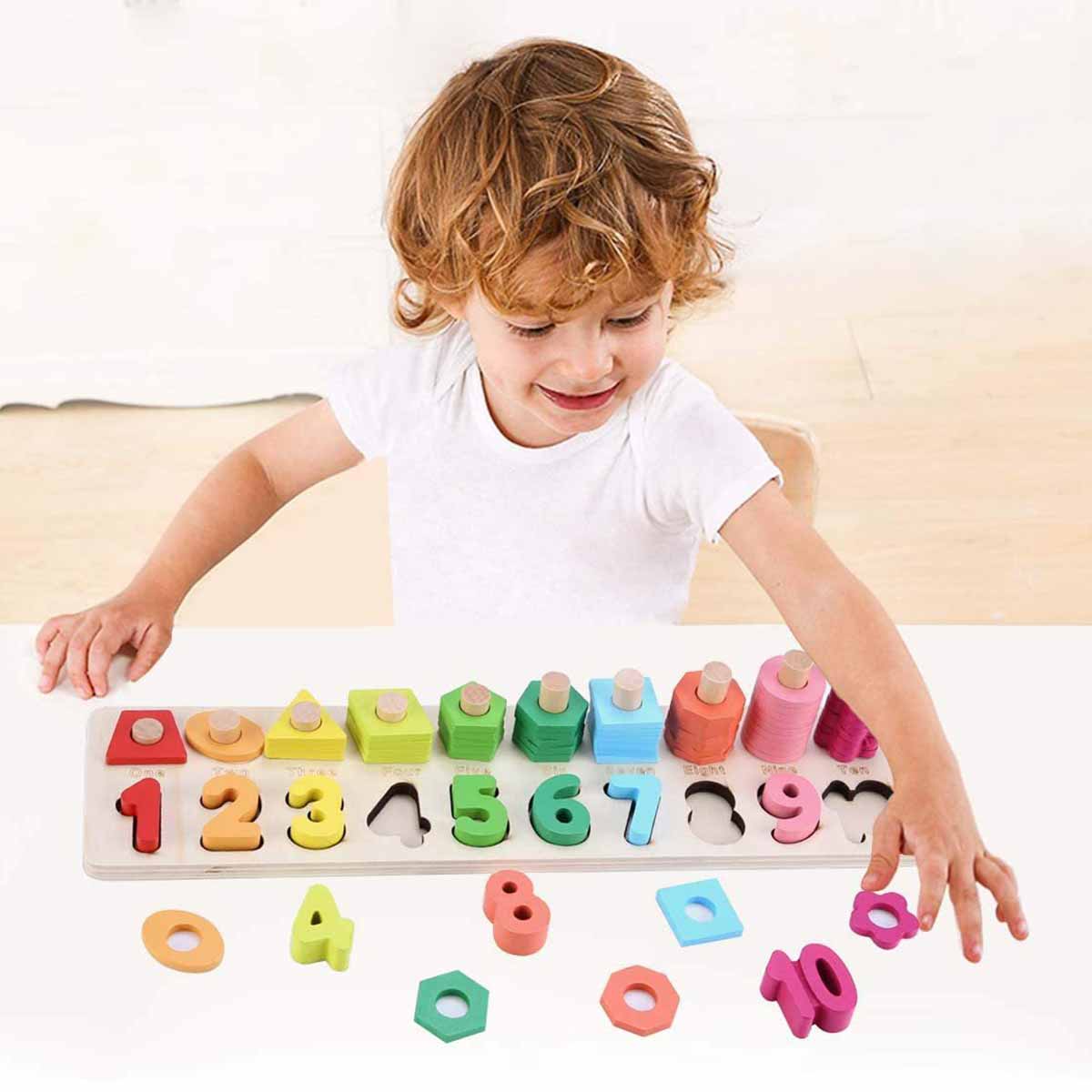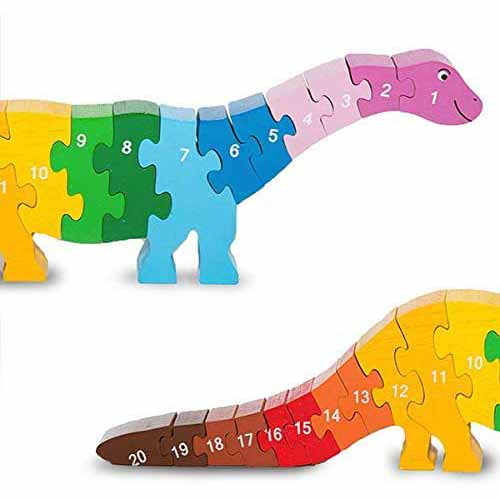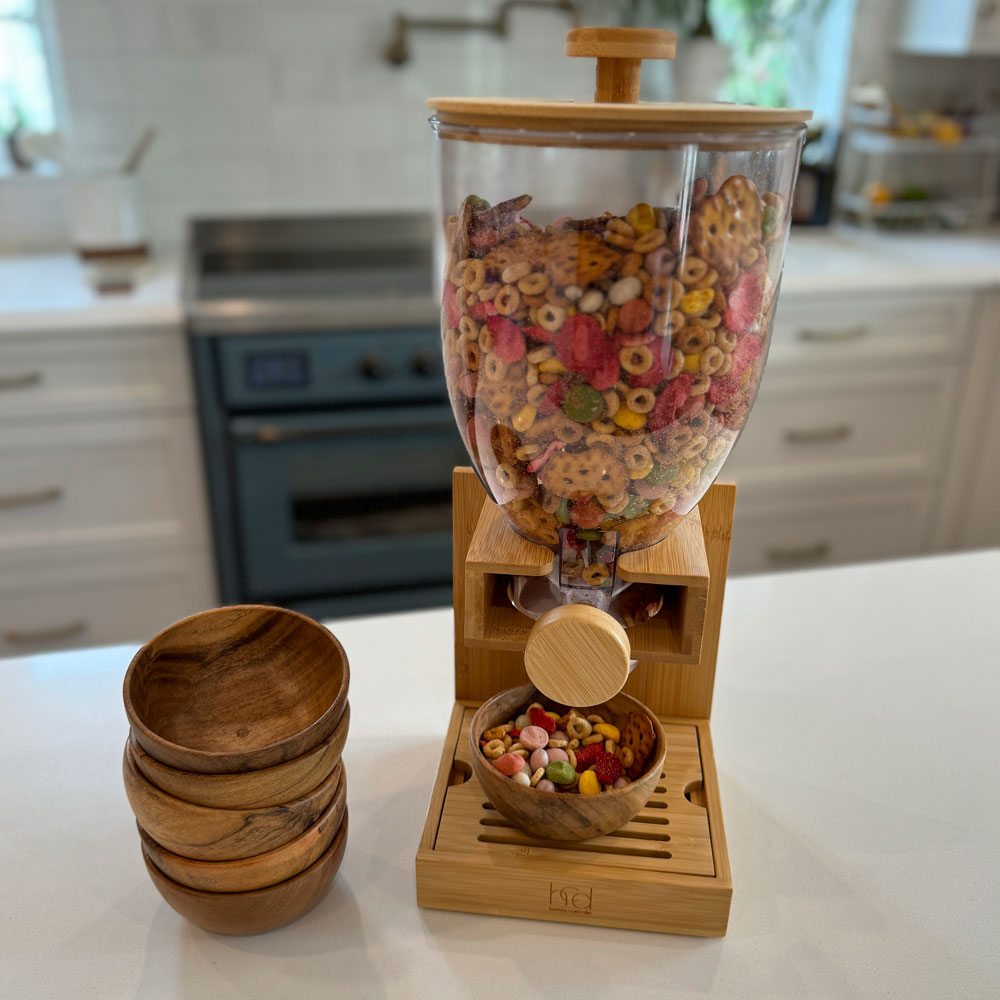Easy DIY Counting Puzzle For Kids
Look at how easy it is to make your very own DIY counting puzzle for kids. Wooden counting boards can be quite the investment, so this is a fun low budget alternative! And all you need is some leftover cardboard and wooden beads.
There are definitely ways you can personalize it or make it more complicated. What I noticed is that kids don’t need complicated, expensive things for learning early math – in fact, they often prefer the simpler options.
Keep reading and discover how easy it is to make your very own puzzle out of some cardboard, glue, twine, and wooden beads.
All activities should be supervised by an adult. As an Amazon Associate I earn from qualifying purchases. This post may contain affiliate links.
Watch the Video to See How to Make the Puzzle!
In this video you’ll see how easy it is to make this puzzle yourself. It may take about 20 minutes to put it all together, but what you will have in the end, is a resource that you can use for number learning time and time again!
Adapt the style to your child’s stage of development. For example, only do numbers 1 through 3 for a young toddler! On the flip side, increase the numbers beyond 10 with older preschoolers!
For written step-by-step instructions, read on below for more information!
Watch the Video to See How to Make the Puzzle!
In this video you’ll see how easy it is to make this puzzle yourself. It may take about 20 minutes to put it all together, but what you will have in the end, is a resource that you can use for number learning time and time again!
Adapt the style to your child’s stage of development. For example, only do numbers 1 through 3 for a young toddler! On the flip side, increase the numbers beyond 10 with older preschoolers!
For written step-by-step instructions, read on below for more information!
Teach Counting with a DIY Puzzle
I love activities where my kids can touch and explore what they are learning. Sensory activities that engage not only their mind but their other senses as well help them learn new concepts faster and more effectively.
With math and early counting, I knew that giving my kids objects they can move and count will help them interact with the numbers better.
After your child counts the wooden beads, they need to match the number to the amount of beads. This will take some interaction from you – look at how they lined it up and let them know if it’s right or if they should count the beads again.
Here’s how to make a DIY counting puzzle for your kiddos. This is a basic tutorial, please change things up and make it fit your child’s needs.
Materials
- 2 Large Identical Pieces of Cardboard
- Glue
- 55 Colored Wooden Beads
- Twine or Rope
- 2 Large Identical Pieces of Cardboard
- Glue
- 55 Colored Wooden Beads
- Twine or Rope
- Craft Knife
- Marker
- Hole Punch
Step-by-Step Instructions
Step 1
Use a sharp craft knife to cut out 10 rectangles from one of the pieces of cardboard. Retain these as they will be your 10 puzzle pieces.
Step 2
To make your puzzle board: glue the piece of cardboard with the holes on top of the other, identical piece of cardboard, and number each hole from 1 to 10.
Step 3
To make your puzzle pieces: use a hole puncher on each end of the rectangular cardboard pieces.
Step 4
Thread a piece of twine through one of the holes and glue it to the other side.
Step 5
Thread beads on each piece of cardboard ranging from 1 to 10.
Step 6
Glue the other end of the twine so as to secure the beads to the puzzle piece, while keeping it moveable.
Step 1
Use a sharp craft knife to cut out 10 rectangles from one of the pieces of cardboard. Retain these as they will be your 10 puzzle pieces.
Step 2
To make your puzzle board: glue the piece of cardboard with the holes on top of the other, identical piece of cardboard, and number each hole from 1 to 10.
Step 3
To make your puzzle pieces: use a hole puncher on each end of the rectangular cardboard pieces.
Step 4
Thread a piece of twine through one of the holes and glue it to the other side.
Step 5
Thread beads on each piece of cardboard ranging from 1 to 10.
Step 6
Glue the other end of the twine so as to secure the beads to the puzzle piece, while keeping it moveable.
Educational Benefits of This DIY Counting Puzzle
There are so many wonderful things that this simple puzzle can teach your child!
Number Recognition: After they count the beads they have to put them in the correct spot. This involves matching the number they counted with the number on the board.
This one simple act exercises their number recognition. It also helps them see how much 1 single bead is compared to 10 beads. This is the foundation of all math skills.
Early Math Skills: There are lots of early math skills that this one simple puzzle teaches.
The first one is number sense – the ability to count forward and backward accurately. As you play with this puzzle, encourage your little one to count the beads backwards too.
It also teaches representation. The number 2 and two beads are the same thing.
If your child is ready for it, they can also practice and learn estimation from it. Let them guess where the pieces fit by estimating how many beads are on the string.
Subtraction: You can also practice subtraction with this puzzle. Since the pieces are all the same size, you can ask your child to move the four green beads in a way that represents the number 3. (put one green bead on the top of the string and three on the bottom, which is a visual representation of the math problem 4-1=3!).
Educational Benefits of This DIY Counting Puzzle
There are so many wonderful things that this simple puzzle can teach your child!
Number Recognition: After they count the beads they have to put them in the correct spot. This involves matching the number they counted with the number on the board.
This one simple act exercises their number recognition. It also helps them see how much 1 single bead is compared to 10 beads. This is the foundation of all math skills.
Early Math Skills: There are lots of early math skills that this one simple puzzle teaches.
The first one is number sense – the ability to count forward and backward accurately. As you play with this puzzle, encourage your little one to count the beads backwards too.
It also teaches representation. The number 2 and two beads are the same thing.
If your child is ready for it, they can also practice and learn estimation from it. Let them guess where the pieces fit by estimating how many beads are on the string.
Subtraction: You can also practice subtraction with this puzzle. Since the pieces are all the same size, you can ask your child to move the four green beads in a way that represents the number 3. (put one green bead on the top of the string and three on the bottom, which is a visual representation of the math problem 4-1=3!)
Store-Bought Math Puzzles
Here are my top picks for the best math puzzles you can buy!
This Montessori activity uses soft pom poms and wooden cupcakes for early counting. It strengthens fine motor skills too.
If you want something really simple, this is perfect! It’s a puzzle made of wooden numbers.
This wooden puzzle lets your toddler match both the number with the correct amount of shapes.
Older kids will love putting together this 3D dinosaur puzzle. The numbers tell them in which order the pieces fit.
What’s Next?
Printable Mother’s Day Cards – A Beautiful and Free Template!
Explore printable Mother’s Day cards & gifts! Don’t miss our free flower template for a heartfelt gift. Make this Mother’s Day unforgettable!
Number Learning Game – Pop and Learn the Numbers!
This number learning game is a playful way to work on number recognition while having some popping fun! A great one for toddlers and prek!
The Best Trail Mix for Kids – Get the Easy and Delicious Recipe!
Unlock the secret to the perfect trail mix for kids! Discover a delicious blend that’s toddler-friendly, healthy, and delicious!


